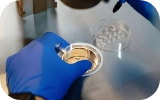Repeated Pregnancy Failures: Role of ERA Test in Success

A modern test called Endometrial Receptivity Array (ERA) helps determine the best time for embryo transfer and achieve early success
Many women trying to conceive through IVF fail the egg implantation process even when embryos appear healthy and the uterine cavity looks normal. Chances are they are having an underlying problem related to the endometrium (the inner lining of the uterus).
One of the causes of infertility is the inability of the uterus to hold on to a healthy embryo. Experts until recently believed that the viability of an embryo is the sole determinant of a successful IVF cycle. But recent studies have discovered that while the quality of embryos is an important factor, the receptivity of the uterus also plays a significant role in deciding the fate of the IVF cycle.
Medical science has now made it possible to determine how receptive a woman’s uterus is in relation to the embryo. The test called Endometrial Receptivity Array (ERA) not only measures the receptivity of the uterus, but also helps determine the exact time for embryo transfer which offers the best chances of success.
Fertility Consultant at Nova IVF Fertility
says “When a plant seed fails to fertilize and grow, the blame may lie with factors related to the seed, the soil or the ecosystem. The same is the case with a human embryo. It is true that embryo quality is the strongest predictor of implantation. But for young women with good quality eggs or those who do not conceive even after undergoing genetic testing, the problem may lie with endometrial factors. It is therefore very important to check the receptivity of the uterus through Endometrial Receptivity Array before proceeding with implantation.”
The ERA test is unique because it examines endometrial receptivity as a product of gene expression of the endometrial lining at specific times during a woman’s ovulation cycle. It monitors the cyclical pattern of 238 different genes and determines a personalized window of implantation for each patient.
ERA has shown high sensitivity and specificity in detecting gene expression profiles associated with receptivity. This has tremendous benefits as it reduces the number of IVF cycles a couple has to undergo to achieve successful pregnancy. The cost and trauma of frequent miscarriages are also eliminated.
“Latest reproductive findings encourage patients to freeze their embryos for transfer at a later cycle, once the harsh effects of fertility drugs on uterus lining have worn off. Endometrial biopsy before embryo transfer can accurately predict the day on which implantation may occur in a subsequent cycle. ERA operates on a similar premise and provides an insight into how receptive a woman’s uterus would be at a particular stage in her menstrual cycle. This enables doctors to determine the best time of embryo transfer for a successful implant.” adds the doctor.
Typically, embryo transfers are performed between day 3 and 5 after egg retrieval. The time of transfer is determined by observing the development process of embryos. Those which stand a strong chance of growing in the lab until day 5 are transferred as blastocysts. Others healthy embryos showing normal growth on day 3 can also be transferred earlier in the hope of achieving implantation.
Previously, doctors had no choice but to repeat IVF cycles endlessly till pregnancy was achieved. Now, ERA has made timely implantation possible. This increases the success rate of pregnancy and reduces the time required to achieve it.
According to experts, ERA results are consistent in different cycles of the same patient when hormonal treatment is maintained. The test is not very expensive considering the overall cost of infertility treatment and the potential benefits of understanding endometrial receptivity in the IVF process.
 Infertility Counselling
Infertility Counselling Female Infertility Treatment
Female Infertility Treatment Andrology Treatment
Andrology Treatment Fertility Enhancing Surgeries - Female
Fertility Enhancing Surgeries - Female Fertility Enhancing Surgeries - Male
Fertility Enhancing Surgeries - Male Endoscopy Treatment
Endoscopy Treatment IUI Treatment
IUI Treatment IVF Treatment
IVF Treatment ICSI Treatment
ICSI Treatment Advanced IVF Solutions
Advanced IVF Solutions Embryology
Embryology Vitrification Egg, Embryo, Sperm Freezing
Vitrification Egg, Embryo, Sperm Freezing Preimplantation Genetic Testing (PGT)
Preimplantation Genetic Testing (PGT) Donation Program Embryo / Egg / Sperm
Donation Program Embryo / Egg / Sperm Self-cycleTM IVF
Self-cycleTM IVF

 Self-cycleTM IVF
Self-cycleTM IVF








